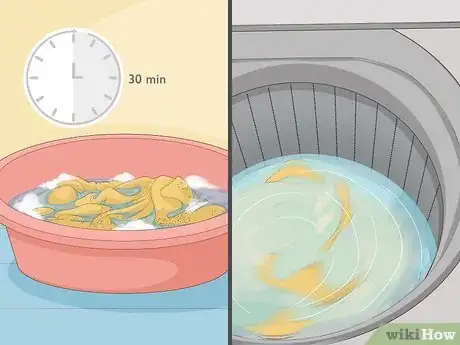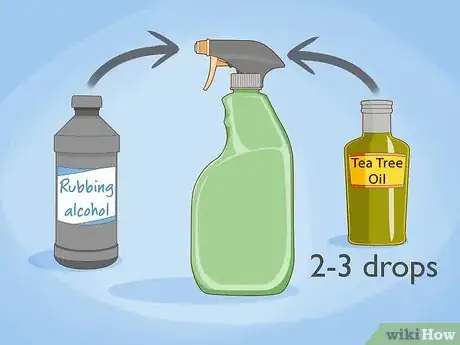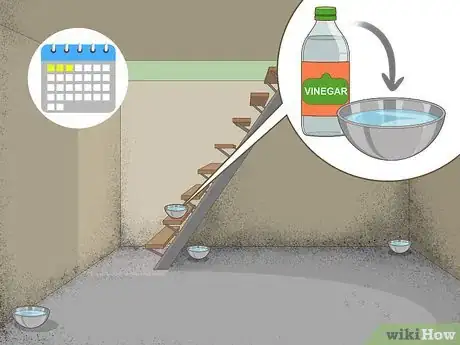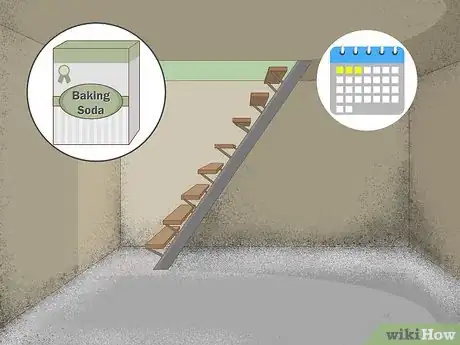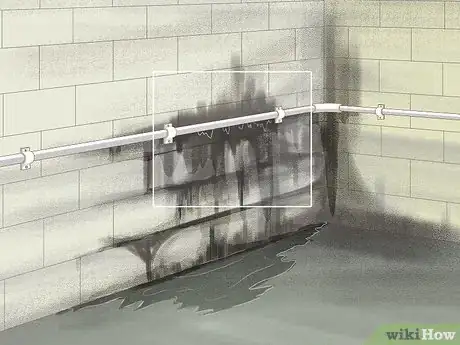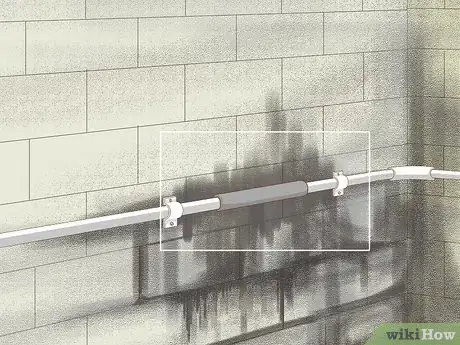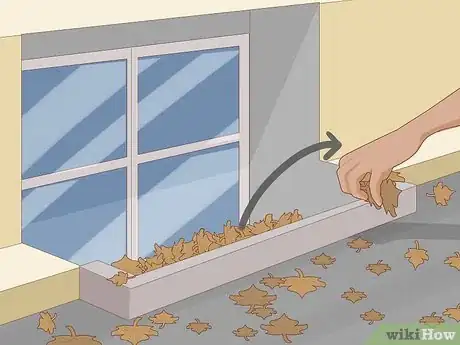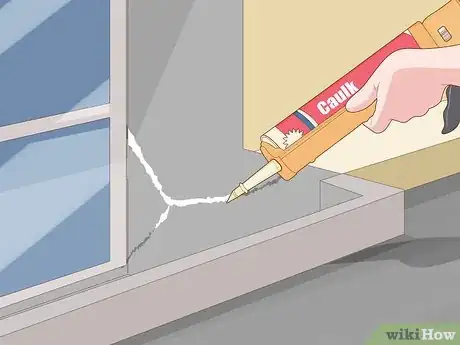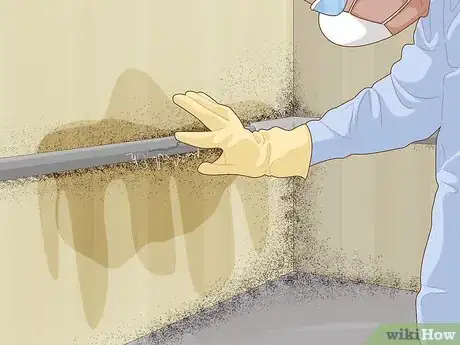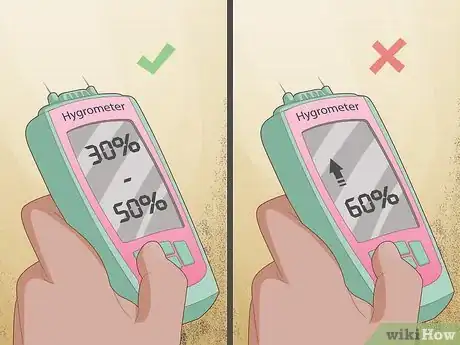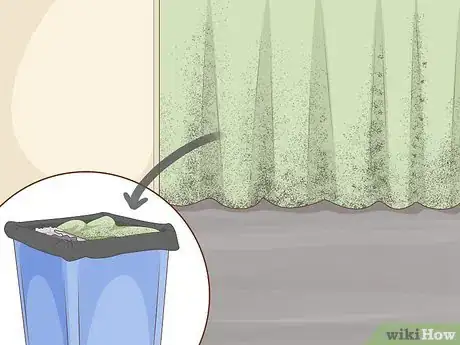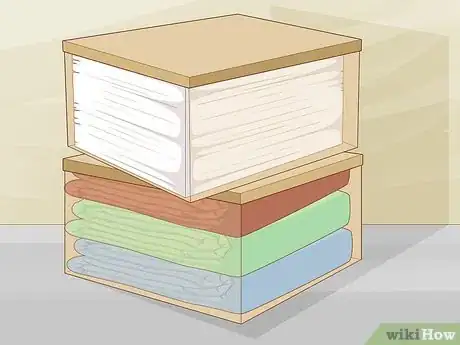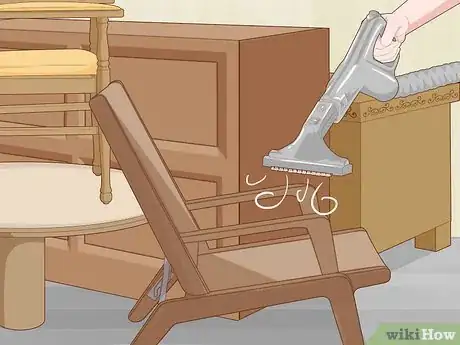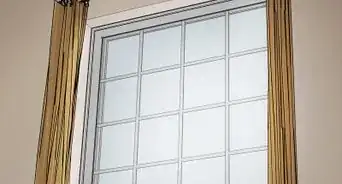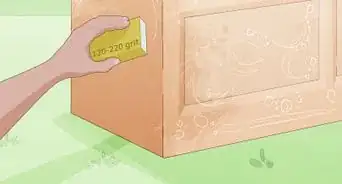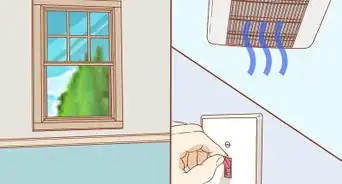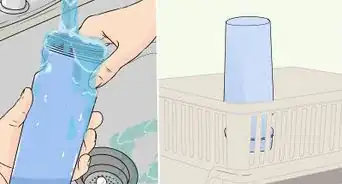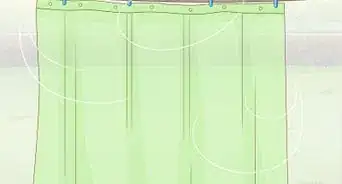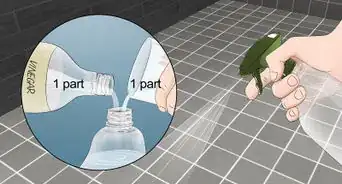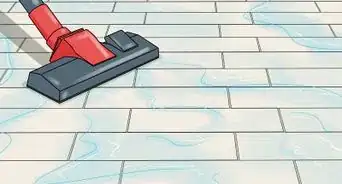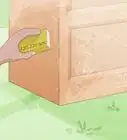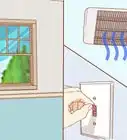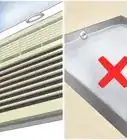This article was co-authored by Mike Kapur and by wikiHow staff writer, Janice Tieperman. Mike Kapur is a home inspector and the owner of Sonic Home Inspections, a home inspection company in Westchester, New York. With over 15 years of experience in pre-inspecting properties, Mike specializes in mold, radon, asbestos, lead, water, and air quality testing as well as hazardous materials, pest, infrared, and general home inspections. Prior to founding Sonic Home Inspections, Mike worked pre-inspecting apartments. Mike holds a BS in Accounting from Queens College and is a Certified Mold Assessor in the state of New York.
There are 7 references cited in this article, which can be found at the bottom of the page.
This article has been viewed 8,670 times.
While it may be tempting to mask the smell of a musty basement with air freshener, it’s important to tackle the foul odor at the source. To get rid of the smell quickly, use vinegar, baking soda, or other household items to deodorize the area. If the musty smell persists, use foam tape, caulk, or gravel to insulate any pipes and windows that are leaking, dripping, or showing signs of condensation. Once you’ve identified and sealed off the source of the musty smell, use a dehumidifier to remove any other bad scents caused by excess moisture.
Steps
Getting Rid of Bad Smells Quickly
-
1Kill any visible mold spots with a bleach solution. Pour 1 cup (240 mL) of bleach into a large bucket or basin. Next, add in 4 cups (950 mL) of water to dilute the cleaning mixture. Put on a pair of rubber gloves, then dip a sponge into the bleach solution. Using the sponge, scrub down any visible mildew from the walls, or any other affected surface. After you’ve wiped down the area, dry off the walls with a clean, unused sponge.[1]
- Try to set up a box fan in your basement so you aren’t breathing in chemical fumes.
- Wear a face mask or respirator as a safety precaution.
- Vinegar is an effective mold-killer that is less harsh than bleach.[2]
-
2Wash any moldy linens or fabrics in the washer with all-fabric bleach. Search around your basement to see if you can find any towels, sheets, clothing items, or other fabrics that reek of mold and mildew. Instead of throwing these items out, soak them in a bucket or basin filled with fabric bleach. Let the items soak for 30 minutes, then place them in a regular wash cycle.[3]
- You might run into this issue more often if you use your basement as an exercising area.
- Be to air-dry or tumble dry the items before moving them back into the basement.
- Be sure to use a non-chlorine bleach if you’re washing colored fabrics, or else they might fade.
Advertisement -
3Make a sanitizing spray with tea tree oil to get rid of any foul scents. Fill a spray bottle with rubbing alcohol, then add in 2-3 drops of tea tree oil. Stir the ingredients together, then spritz the mixture all over your basement. Focus specifically on areas that smell musty, like a piece of furniture. Use this spray as often as needed to get rid of any foul scents.[4]
- Tea tree oil eliminates mold spores naturally. If you prefer organic cleaning methods, it’s a great ingredient to have on hand.
- Rubbing alcohol has sanitizing properties, which makes it especially useful in this mixture.
-
4Place vinegar-filled bowls around your basement for 3-4 days. Fill several small bowls with white vinegar. Take them down to your basement and position them in areas where the smell of mold and mustiness is especially strong. Leave these bowls in place for 3-4 days, or until you notice the musty smell disappearing from the area.[5]
- White vinegar helps to soak up any bad smells in the basement.
- You can also fill open containers with cat litter, which will also absorb the scent of mildew.[6]
-
5Deodorize the area with baking soda if you don’t like vinegar. Fill several bowls with plain baking soda, then arrange them in different corners of your basement. Leave these bowls in place for 3-4 days, or until you notice the musty smell vanishing from your basement.[7]
Tip: If natural methods like baking soda, cat litter, and white vinegar don’t get rid of the scent, try using a stronger deodorizing product like DampRid. You can find this product online.
Identifying the Source of the Odor
-
1Check your pipes for signs of leaking or condensation. Walk around the perimeter of your basement and thoroughly examine any exposed pipes. Since musty smells are usually caused by mildew, check for any pipes that are “sweating,” or visibly dripping. Next, put on a pair of work gloves and touch the surface of any bare pipes to see if they’ve collected any condensation, as this could also be a source of the bad smell.[8]
- Make sure to examine all the pipes in your basement. There may be more than 1 pipe that’s dripping or collecting moisture.
-
2Surround any bare, dripping pipes with foam pipe wrap. Examine the pipe carefully to find the exact areas where the pipe is dripping. To seal off this area, slide a pre-cut strip of foam pipe wrap over the wet area and secure it into place with a piece of duct tape. Repeat this process along any other damp pipes to get rid of extra moisture.[9]
- The strips of foam are pre-cut in the package, so you don’t have to worry about trimming or adjusting them.
- You can find foam pipe wrap online or in most hardware or home improvement stores.
-
3Empty and clean the wells outside your basement window. If your basement windows are surrounded by wells, or a deep pit that separates the window from the yard, check the area for leaves and other debris. If the window well is filled with waste, it could cause a lot of water build-up near the windows after a rainstorm. While wearing gloves, use either your hands or a shovel to clear out the well.[10]
- If your window wells fill up with debris on a regular basis, set aside a time each month to clean them out.
-
4Examine any windows to see if they’re a source of unwanted moisture. Check the windowsills, edges, and walls surrounding your basement windows. Specifically, be on the lookout for fissures, or other leaks where water could be getting through. Take a look at the individual panes as well to see if there are any cracks.[11]
- If the window is broken, call a repair person to replace it.
-
5Fill any cracks and leaks around the window seals with caulk. Search along the walls next to your windows for any distinct cracks. If you see any fissures, use caulk to fill and block off the crack, which can prevent moisture from seeping in through the outside. If your walls are prone to leaks and cracks, do a quick scan each month to make sure that your basement walls are sturdy and free of any fissures.[12]
- Caulk all the cracks that you find in your wall, no matter how small they are. Any kind of fissure can be an unwanted source of moisture and mustiness in your basement.
-
6Pour gravel into the window wells to serve as a water buffer. Search a hardware, home improvement, or gardening supply shop for a bag or 2 of fine gravel. Completely fill your window wells with the gravel, so no debris can get stuck there.[13]
- If you aren’t sure what kind of product to purchase, ask a hardware or home improvement store associate for help.
-
7Call a professional repair specialist if your pipes or windows are leaking. Search online to find a plumber or other repair professional in your area. If your pipes or windows are leaking significantly (instead of just “sweating”), contact a plumber so they can take a closer look. If you don’t want to call someone for help, you can also try fixing the leak yourself.[14]
Preventing Humidity and Mold
-
1Test your basement’s humidity level with a hygrometer. Power on your device and place it in the center of your basement. After a few hours, monitor the hygrometer to see what percentage of humidity is currently in the room. If the percentage is between 30 and 50%, your basement isn’t at risk of developing mold; however, a humidity level above 60% could cause room for concern.[15]
- You can purchase a hygrometer online, or you can make your own.
-
2Set a dehumidifier in your basement to reduce condensation.[16] If the humidity level in your basement is over 60%, arrange a dehumidifier in the area and power it on. Leave this device on indefinitely to continuously get rid of moisture and mustiness from your basement.[17] While any kind of dehumidifier will get the job done, you might have extra luck with a larger, compressor dehumidifier.[18]
- Compressor dehumidifiers use a storage tank to collect moisture.
- Any kind of dehumidifier can be purchased online.
- Some dehumidifier models might have an internal hygrometer, which can better monitor the humidity levels in your basement.
-
3Discard any damp or moldy items currently in your basement. Check your storage bins, shelving, and any other cluttered areas for moist, rotting items. As you scan the area, place anything moldy in a trash bag, so you can remove it from the basement. If an object seems damp but doesn’t show signs of mold, consider washing or airing it out in a different location.[19]
- Damp items don’t necessarily need to be thrown out. For instance, if you find moist bed sheets in your basement, you can re-wash them on a high, antibacterial setting in your washer.
-
4Store loose items in secure, plastic storage bins. Sort through the different objects and memorabilia that you usually keep down in your basement. To keep these items as fresh as possible, arrange them in an airtight plastic storage bin. Use a variety of bins to better organize your belongings for later.[20]
- Try creating an organizational system for your items! For example, you could place old scrapbooks and photos in 1 bin, then place your bedding and tablecloths in another.
-
5Vacuum and wash off any wooden furniture to kill the mold. If you notice mold forming on any wooden furniture, you don’t have to throw the item out immediately; instead, put on an air mask, then use a handheld vacuum or canister attachment to remove any blatant spores. Stir a cherry-sized amount of dish soap into a bucket of warm butter, then use a soft-bristled to scrub down the wood. After you’ve washed off the surface, rinse off the wood with clean water.[21]
- If you’re dealing with raw wood, you can use bleach to clean off the surface in lieu of soap and water.
Expert Q&A
Did you know you can get expert answers for this article?
Unlock expert answers by supporting wikiHow
-
QuestionHow can I prevent mold from growing?
 Mike KapurMike Kapur is a home inspector and the owner of Sonic Home Inspections, a home inspection company in Westchester, New York. With over 15 years of experience in pre-inspecting properties, Mike specializes in mold, radon, asbestos, lead, water, and air quality testing as well as hazardous materials, pest, infrared, and general home inspections. Prior to founding Sonic Home Inspections, Mike worked pre-inspecting apartments. Mike holds a BS in Accounting from Queens College and is a Certified Mold Assessor in the state of New York.
Mike KapurMike Kapur is a home inspector and the owner of Sonic Home Inspections, a home inspection company in Westchester, New York. With over 15 years of experience in pre-inspecting properties, Mike specializes in mold, radon, asbestos, lead, water, and air quality testing as well as hazardous materials, pest, infrared, and general home inspections. Prior to founding Sonic Home Inspections, Mike worked pre-inspecting apartments. Mike holds a BS in Accounting from Queens College and is a Certified Mold Assessor in the state of New York.
Certified Mold Assessor & Home Inspector, Sonic Home Inspections
-
QuestionWhat causes mold in a basement?
 Mike KapurMike Kapur is a home inspector and the owner of Sonic Home Inspections, a home inspection company in Westchester, New York. With over 15 years of experience in pre-inspecting properties, Mike specializes in mold, radon, asbestos, lead, water, and air quality testing as well as hazardous materials, pest, infrared, and general home inspections. Prior to founding Sonic Home Inspections, Mike worked pre-inspecting apartments. Mike holds a BS in Accounting from Queens College and is a Certified Mold Assessor in the state of New York.
Mike KapurMike Kapur is a home inspector and the owner of Sonic Home Inspections, a home inspection company in Westchester, New York. With over 15 years of experience in pre-inspecting properties, Mike specializes in mold, radon, asbestos, lead, water, and air quality testing as well as hazardous materials, pest, infrared, and general home inspections. Prior to founding Sonic Home Inspections, Mike worked pre-inspecting apartments. Mike holds a BS in Accounting from Queens College and is a Certified Mold Assessor in the state of New York.
Certified Mold Assessor & Home Inspector, Sonic Home Inspections
Things You’ll Need
Getting Rid of Bad Smells
- Bleach
- Fabric bleach
- Spray bottle
- Rubbing alcohol
- Tea tree essential oil
- Bowls
- White vinegar
- Cat litter
- Baking soda
- Deodorizing salt mixture (e.g., DampRid)
- Litter box
Identifying the Source of the Odor
- Foam pipe wrap
- Gravel
- Caulk
Preventing Humidity and Mold
- Hygrometer
- Dehumidifier
- Plastic storage bins
- Dish soap
- Soft-bristled brush
- Water
- Vacuum
- Rubber gloves
- Air mask
- Bleach (optional)
References
- ↑ https://www.bobvila.com/articles/how-to-get-rid-of-mildew-smell/
- ↑ Mike Kapur. Certified Mold Assessor & Home Inspector, Sonic Home Inspections. Expert Interview. 19 August 2020.
- ↑ https://www.bobvila.com/articles/how-to-get-rid-of-mildew-smell/
- ↑ https://www.thisoldhouse.com/ideas/get-rid-bad-smells-safe-way
- ↑ https://www.readersdigest.ca/home-garden/home-improvement/musty-smell-basement/
- ↑ https://www.readersdigest.ca/home-garden/home-improvement/musty-smell-basement/
- ↑ https://www.bobvila.com/articles/musty-smell-in-basement/
- ↑ https://www.thisoldhouse.com/ask-toh/sweating-pipes
- ↑ https://www.bobvila.com/articles/musty-smell-in-basement/
- ↑ https://www.thisoldhouse.com/ideas/get-rid-bad-smells-safe-way
- ↑ https://www.thisoldhouse.com/ideas/get-rid-bad-smells-safe-way
- ↑ https://www.bobvila.com/articles/musty-smell-in-basement/
- ↑ https://www.bobvila.com/articles/musty-smell-in-basement/
- ↑ https://www.bobvila.com/articles/musty-smell-in-basement/
- ↑ https://www.bobvila.com/articles/musty-smell-in-basement/
- ↑ Mike Kapur. Certified Mold Assessor & Home Inspector, Sonic Home Inspections. Expert Interview. 19 August 2020.
- ↑ https://www.thisoldhouse.com/ideas/get-rid-bad-smells-safe-way
- ↑ https://www.bobvila.com/articles/musty-smell-in-basement/
- ↑ https://www.bobvila.com/articles/musty-smell-in-basement/
- ↑ https://www.bobvila.com/articles/musty-smell-in-basement/
- ↑ https://www.bobvila.com/articles/how-to-remove-mold-from-wood/
- ↑ Mike Kapur. Certified Mold Assessor & Home Inspector, Sonic Home Inspections. Expert Interview. 19 August 2020.


